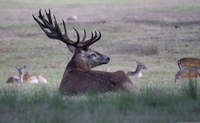Prairie Fare: The wild side of the menu — Safe cooking with wild game
(Click an image below to view a high-resolution image that can be downloaded)
“If it were up to you, all the deer would be living in our garage,” my dad said to me.
I squinted at him sideways and grinned. He knew me well.
My dad was tracking the deer tags from local hunters. I was looking at the animals in the back of pickup trucks.
We lived in an area where herds of deer were less than a mile from our town. I once counted 150 deer studying me from a corn field.
Driving was a little treacherous, especially at dusk. Sometimes we’d stop our vehicle and let the herd travel around us on the highway.
“Watch out for deer!” was the usual farewell when I drove back to college.
Unfortunately, a deer recently jumped into the side of my car in Minnesota lakes county. My daughter was borrowing my car. The entire driver side was smashed, but thankfully, my daughter and her husband were unharmed.
I forgot to give them the Midwestern warning.
“It could have been worse,” my parents would have said.
Although I have never been a hunter, I understand that deer hunting season provides several benefits. It helps with wildlife management by preventing overpopulation, provides healthful food and offers a recreational opportunity. Some food pantries accept donations of wild game.
Hunting stimulates the economy through equipment purchases, lodging and meals.
When I first began in my role as a North Dakota State University Extension specialist, my first assignment was to create some pocket guides about deer, elk and game birds that took into account nutrition and food safety.
Sadly, my original coauthors, Marty Marchello and Pat Beck, have both passed away. I learned a lot from their mentorship, and I do my best to keep the content up to date many years after we wrote the original “Wild Side of the Menu” and pocket guide handouts.
Venison — deer, elk, antelope or moose meat — can add variety to your menu. The word “venison” is derived from the word “venari,” which is the Latin word meaning “to hunt.” A 3-ounce portion of venison has about 130 calories and 3 grams of fat. Game meats have a characteristic flavor, depending on the species, the age of the animals and the animals’ feeding practices.
As with other types of meat, wild game may become contaminated with bacteria anywhere from field to table. If you’re field dressing your own animals, take precautions to avoid contamination and to keep the carcass cool in unseasonably warm autumn weather.
In fact, wild game is typically so lean that we need to add fat or sauces to prevent it from having a dry texture.
Like other high-protein foods, wild game must be handled carefully in the kitchen. Depending on the skill of the person doing the butchering, wild game could become contaminated from the animal’s gastrointestinal tract.
Follow these food safety rules for game meats or nearly any high-protein food.
- Wash your hands for at least 20 seconds with soap and water before beginning to work and changing tasks.
- Start with clean equipment, including knives and cutting boards. After using, wash thoroughly with hot soapy water. Rinse thoroughly and sanitize with a solution of 1 tablespoon chlorine bleach per gallon of water, then allow the equipment to air-dry.
- Check out the best practices for freezing game meat to avoid freezer burn. When thawing frozen meat, place it in the refrigerator at 40 degrees Fahrenheit or below on the lowest shelf to prevent juices from dripping onto ready-to-eat foods.
- Consider marinating the meat, but do so in the refrigerator. Don’t reuse marinade. If you want to use the marinade as a sauce, save some marinade separately.
- Cook game meats to an internal temperature, as measured with a food thermometer, to 160 degrees F for ground venison. Game birds should reach 165 degrees F.
- Promptly refrigerate in shallow pans and reheat within a few days or freeze.
Do you want to learn more? See the nine wild game publications at ndsu.ag/wildgame25 for recipes and many tips.
Try this recipe with venison or beef.
Venison or Beef Stroganoff
1 ½ pounds ground venison or ground beef
1 to 2 tablespoons cooking oil (if using venison)
1 medium onion, chopped
1 (10.25-ounce) can reduced-fat cream of mushroom soup
1 (4-ounce) can mushrooms, drained
½ cup light sour cream
3 cups cooked noodles or rice
Brown ground venison and onion in oil. If using beef, omit oil and drain after browning. Stir in soup, sour cream and mushrooms. Heat to an internal temperature of 160 degrees. Serve over cooked noodles or rice.
Makes six servings. Each serving has 380 calories, 15 g of fat, 30 grams (g) protein, 29 g carbohydrate, 2 g fiber and 550 milligrams sodium.
(Julie Garden-Robinson, Ph.D., R.D., L.R.D., is a North Dakota State University Extension food and nutrition specialist and professor in the Department of Health, Nutrition and Exercise Sciences.)
NDSU Agriculture Communication – Oct. 23, 2025
Source: Julie Garden-Robinson, 701-231-7187, julie.garden-robinson@ndsu.edu
Editor: Dominic Erickson, 701-231-5546, dominic.erickson@ndsu.edu




